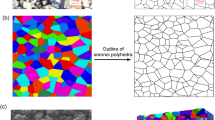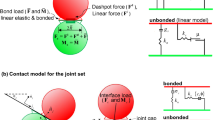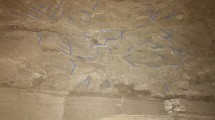Abstract
Discrete element method (DEM) is employed to investigate the fracture growth and failure mechanism of increasingly jointed rock samples subjected to increasing confinements. Synthetic rock mass models are developed on the basis of joint configurations created within laboratory samples, and the micromechanical parameters of the DEM are calibrated to replicate the mechanical response measured in the laboratory. Subsequently, the effects of increasing the level of initial joint frequency and confining pressure on the strength, deformability, stress–strain relationship, and failure mode transition of the rock samples are analyzed. At the microscopic scale the tensile and shear crack distributions, fragmentation characteristics, AE frequency–magnitude statistics and spatial clustering of source locations are examined to shed light on the mechanical behavior and deformability of jointed rock mass. Results show that the distribution of the magnitude of AE events is prone to decay as power law in tandem with the spatial distribution of the source locations that exhibit a fractal character. Noteworthy is the decrease of seismic \(b\) values associated with failure pattern from axial splitting to shear fracture upon increase in confining pressure, which is indicative of an accelerating number of events of increased magnitudes. Finally, the microscopic evolution of the fabric and force anisotropy as well as the characteristics of spatial distribution of contact forces provide micromechanical insights into the macroscopic behavior of jointed rock samples upon the rise in confining pressure.
Highlights
-
This study addresses an important problem related to the initiation, evolution and propagation of failure in jointed rock mass using discrete element method
-
Acoustic emission is employed to shed some light on the mechanical behavior and deformability of jointed rock mass
-
Microscale characterization of fracture growth mechanism of jointed rock samples are achieved by examination of the microstructure and stress transmission
















Similar content being viewed by others
References
Aki K (1965) Maximum likelihood estimate of b in the formula log N = a–bM and its confidence limits. Bull Earthq Res Inst 43:237–239
Alejano LR, Arzúa J, Bozorgzadeh N, Harrison JP (2017) Triaxial strength and deformability of intact and increasingly jointed granite samples. Int J Rock Mech Min Sci 95:87–103
Amitrano D, Schmittbuhl J (2002) Fracture roughness and gouge distribution of a granite shear band. J Geophys Res 107:2375
Amitrano D, Grasso JR, Hantz D (1999) From diffuse to localised damage through elastic interaction. Geophys Res Lett 26(14):2109–2112
Azéma E, Radjaï F (2012) Force chains and contact network topology in sheared packings of elongated particles. Phys Rev E 85(3):031303
Azéma E, Radjaï F, Peyroux R, Saussine G (2007) Force transmission in a packing of pentagonal particles. Phys Rev E 76:011301
Bahaaddini M, Sharrock G, Hebblewhite BK (2013) Numerical investigation of the effect of joint geometrical parameters on the mechanical properties of a non-persistent jointed rock mass under uniaxial compression. Comput Geotech 49:206–225
Bahaaddini M, Hagan PC, Mitra R, Hebblewhite BK (2015) Parametric study of smooth joint parameters on the shear behaviour of rock joints. Rock Mech Rock Eng 48(3):923–940
Bahrani N, Kaiser PK (2017) Estimation of confined peak strength of crack-damaged rocks. Rock Mech Rock Eng 50(2):309–326
Bastola S, Cai M (2020) Investigation of mechanical properties of jointed granite under compression using lattice-spring-based synthetic rock mass modeling approach. Int J Rock Mech Min Sci 126:104191
Bathurst RJ, Rothenburg L (1990) Observations on stress–force–fabric relationships in idealized granular materials. Mech Mater 9(1):65–80
Baud P, Schubnel A, Wong TF (2000) Dilatancy, compaction, and failure mode in Solnhofen limestone. J Geophys Res 105(B8):19289–19303
Bender B (1983) Maximum-likelihood estimation of values for magnitude grouped data. Bull Seismol Soc Am 73(3):831–851
Cárdenas-Barrantes M, Cantor D, Barés J, Renouf M, Azéma E (2021) Micromechanical description of the compaction of soft pentagon assemblies. Phys Rev E 103:062902
Cheng C, Chen X, Zhang S (2016) Multi-peak deformation behavior of jointed rock mass under uniaxial compression: Insight from particle flow modeling. Eng Geol 213:25-45
Cho N, Martin CD, Sego DC (2007) A clumped particle model for rock. Int J Rock Mech Min Sci 44(7):997–1010
Coetzee CJ (2016) Calibration of the discrete element method and the effect of particle shape. Powder Technol 297:50–70
Cundall PA, Strack ODL (1979) A discrete element model for granular assemblies. Geotéchnique 29(1):47–65
Dinç O, Scholtès L (2018) Discrete analysis of damage and shear banding in argillaceous rocks. Rock Mech Rock Eng 51:1521–1538
Duan K, Kwok CY, Ma X (2017) DEM simulations of sandstone under true triaxial compressive tests. Acta Geotech 12:495–510
Einstein HH, Hirschfeld RC (1973) Model studies on mechanics of jointed rocks. ASCE J Soil Mech Found Div Proc 1973:229–248
Fan X, Kulatilakec PHSW, Chen X (2015) Mechanical behavior of rock-like jointed blocks with multi-non-persistent joints under uniaxial loading: a particle mechanics approach. Eng Geol 190:17–32
Feng P, Xu Y, Dai F (2021) Effects of dynamic strain rate on the energy dissipation and fragment characteristics of cross-fissured rocks. Int J Rock Mech Min Sci 138:1
Gao G, Meguid MA (2018) Effect of particle shape on the response of geogrid-reinforced systems: insights from 3D discrete element analysis. Geotext Geomembr 46(6):685–698
Gao G, Meguid MA (2021) On the role of joint roughness on the micromechanics of rock fracturing process: a numerical study. Acta Geotech. https://doi.org/10.1007/s11440-021-01401-8
Gao G, Meguid MA, Chouinard LE (2020) On the role of pre-existing discontinuities on the micromechanical behavior of confined rock samples: a numerical study. Acta Geotech 15:3483–3510
Gao G, Meguid MA, Chouinard LE, Zhan WW (2021) Dynamic disintegration processes accompanying transport of an earthquake-induced landslide. Landslides 18(3):909–933
Ghazvinian A, Sarfarazi V, Schubert W, Blumel M (2012) A study of the failure mechanism of planar non-persistent open joints using PFC2d. Rock Mech Rock Eng 45:677–693
Guo N, Zhao JD (2013) The signature of shear-induced anisotropy in granular media. Comput Geotech 47:1–15
Gutenberg B, Richter CF (1944) Frequency of earthquakes in California. Bull Seismol Soc Am 34(4):185–188
Hamdi P, Stead D, Elmo D (2014) Damage characterization during laboratory strength testing: a 3D-finite-discrete element approach. Comput Geotech 60:33–46
Hazzard JF, Young RP (2000) Simulating acoustic emissions in bonded-particle models of rock. Int J Rock Mech Min Sci 378:67–72
Hazzard JF, Young RP (2002) Moment tensors and micromechanical models. Tectonophysics 356:181–197
Hazzard JF, Young RP (2004) Dynamic modeling of induced seismicity. Int J Rock Mech Min Sci 41:1365–1376
Hazzard JF, Young RP, Maxwell SC (2000) Micromechanical modeling of cracking and failure in brittle rocks. J Geophys Res 105:16683–16697
Hirata T, Satoh T, Ito K (1987) Fractal structure of spatial distribution of microfracturing in rock. Geophys J R Abstr Soc 90(2):369–374
Hosseininia ES (2012) Investigating the micromechanical evolutions within inherently anisotropic granular materials using discrete element method. Granul Matter 14:483–503
Huang F, Shen J, Cai M, Xu CS (2019) An empirical UCS model for anisotropic blocky rock masses. Rock Mech Rock Eng 52:3119
Hurley RC, Hall SA, Andrade JE, Wright J (2016) Quantifying interparticle forces and heterogeneity in 3D granular materials. Phys Rev Lett 117:098005
Itasca Consulting Group, Inc. (2019) PFC — Particle Flow Code in 2 and 3 Dimensions, Version 6.0, Documentation Set of version 6.00.17. Minneapolis: Itasca.
John KW (1969) Festigkeit und Verformbarkeit von druckfesten regelmässig gefügten Diskontinuen. Heft 37. Universität Fridericiana, Kurlsruhe (Inst Soil Mech Rock Mech)
Ke CC, Chen CS, Ku CY, Chen CH (2009) Modeling crack propagation path of anisotropic rocks using boundary element method. Int J Numer Anal Meth Geomech 33(9):1227–1253
Kuhn MR (2010) Micro-mechanics of fabric and failure in granular materials. Mech Mater 42(9):827–840
Kulatilake PHSW, He W, Um J, Wang H (1997) A physical model study of jointed rock mass strength under uniaxial compressive loading. Int J Rock Mech Min Sci 34(3):165.e1-165.e15
Li HQ, Wong LNY (2012) Influence of flaw inclination angle and loading condition on crack initiation and propagation. Int J Solids Struct 49:482–499
Lisjak A, Liu Q, Zhao Q, Mahabadi OK, Grasselli G (2013) Numerical simulation of acoustic emission in brittle rocks by two-dimensional finite-discrete element analysis. Geophys J Int 195(1):423–443
Lockner D (1993) The role of acoustic emission in the study of rock fracture. Int J Rock Mech Min Sci Geomech Abstr 30(7):883–899
Lois G, Lemaître A, Carlson J (2007) Spatial force correlations in granular shear flow. I. Numerical evidence. Phys Rev E 76(2):021302
Madariaga R (1976) Dynamics of an expanding circular fault. Bull Seismol Soc Am 66:639–666
Mas Ivars D, Pierce ME, Darcel C, Reyes-Montes J, Potyondy DO, Young RP, Cundall PA (2011) The synthetic rock mass approach for jointed rock mass modelling. Int J Rock Mech Min Sci 48(2):219–244
Misra A (1999) Micromechanical model for anisotropic rock joints. J Geophys Res Solid Earth 104:23175–23187
Morgan JK (2015) Effects of cohesion on the structural and mechanical evolution of fold and thrust belts and contractional wedges: Discrete element simulations. J Geophys Res Solid Earth 120:3870–3896
Nguyen DH, Azéma E, Radjai F, Sornay P (2014) Effect of size polydispersity versus particle shape in dense granular media. Phys Rev E 90:012202
Ouadfel H, Rothenburg L (2001) ‘Stress–force–fabric’ relationship for assemblies of ellipsoids. Mech Mater 33(4):201–221
Park B, Min KB (2015) Bonded-particle discrete element modeling of mechanical behavior of transversely isotropic rock. Int J Rock Mech Min Sci 76:243–255
Paterson MS, Wong T-F (2005) Experimental rock deformation: the brittle field, 2nd edn. Springer-Verlag, Berlin
Peng J, Wong LNY, Teh CI, Li Z (2017) Modeling micro-cracking behavior of Bukit Timah granite using grain-based model. Rock Mech Rock Eng 15(1–2):1–20
Potyondy DO (2015) The bonded-particle model as a tool for rock mechanics research and application: current trends and future directions. Geosyst Eng 18(1):1–28
Potyondy DO, Cundall PA (2004) A bonded-particle model for rock. Int J Rock Mech Min Sci 41(13):29–64
Scholz C (1990) The mechanics of earthquakes and faulting. Cambridge Univ. Press, Cambridge, p 439
Shang J, West LJ, Hencher SR, Zhao Z (2018) Tensile strength of larger-scale incipient rock joints: a laboratory investigation. Acta Geotech 13:869–886
Shen W, Zhao T, Crosta GB et al (2017) Analysis of impact-induced rock fragmentation using a discrete element approach. Int J Rock Mech Min 98:33–38
Sinha S, Shirole D, Walton G (2020) Investigation of the micromechanical damage process in a granitic rock using an inelastic bonded block model (BBM). J Geophys Res 125:e2019JB018844
van der Baan M, Chorney D (2019) Insights from micromechanical modeling of intact rock failure: event characteristics, stress drops and force networks. J Geophys Res Solid Earth 124:12955–12980
Vergara MR, Jan MVS, Lorig L (2016) Numerical model for the study of the strength and failure modes of rock containing non-persistent joints. Rock Mech Rock Eng 49(4):1211–1226
Vora HB, Morgan JK (2019) Microscale characterization of fracture growth and associated energy in granite and sandstone analogs: insights using the discrete element method. J Geophys Res Solid Earth 124:7993–8012
Walton G, Alejano LR, Arzua J, Markley T (2018) Crack damage parameters and dilatancy of artificially jointed granite samples under triaxial compression. Rock Mech Rock Eng 51:1637–1656
Walton G, Labrie D, Alejano LR (2019) On the residual strength of rocks and rockmasses. Rock Mech Rock Eng 52(11):4821–4833
Wang JF, Yan HB (2013) On the role of particle breakage in the shear failure behavior of granular soils by DEM. Int J Numer Anal Methods Geomech 37(8):832–854
Wang B, Chen Y, Wong T (2008) A discrete element model for the development of compaction localization in granular rock. J Geophys Res 113:B03202
Wiemer S, Wyss M (2000) Minimum magnitude of completeness in earthquake catalogs: examples from Alaska, the Western United States, and Japan. Bull Seismol Soc Am 90(4):859869
Woessner J, Wiemer S (2005) Assessing the quality of earthquake catalogues: estimating the magnitude of completeness and its uncertainty. Bull Seismol Soc Am 95(2):684–698
Wong LNY, Li HQ (2013) Numerical study on coalescence of two pre-existing coplanar flaws in rock. Int J Solid Struct 50(22–23):3685–3706
Wong TF, David C, Zhu W (1997) The transition from brittle faulting to cataclastic flow in porous sandstones: Mechanical deformation. J Geophys Res 102:3009–3025
Yang SQ, Yang Z, **g HW, Xu T (2019) Fracture evolution mechanism of hollow sandstone under conventional triaxial compression by X-ray micro-CT observations and three-dimensional numerical simulations. Int J Solids Struct 190(5):156–180
Zhang XP, Wong L (2012) Cracking processes in rock-like material containing a single flaw under uniaxial compression: a numerical study based on parallel bonded-particle model approach. Rock Mech Rock Eng 45:711–737
Zhang XP, Zhang Q, Wu SC (2017) Acoustic emission characteristics of the rock-like material containing a single flaw under different compressive loading rates. Comput Geotech 83:83–97
Zhang SH, Wu SC, Duan K (2019) Study on the deformation and strength characteristics of hard rock under true triaxial stress state using bonded-particle model. Comput Geotech 112:1–16
Zhao Q, Lisjak A, Mahabadi O, Liu QY, Grasselli G (2014) Numerical simulation of hydraulic fracturing and associated microseismicity using finite-discrete element method. J Rock Mech Geotech Eng 6(6):574–581
Zhao C, Zhou YM, Cf Z (2018) Cracking processes and coalescence modes in rock-like specimens with two parallel pre-existing cracks. Rock Mech Rock Eng 51:3377–3393
Zhao XY, Elsworth D, He YL, Hu WR, Wang T (2021) A grain texture model to investigate effects of grain shape and orientation on macro-mechanical behavior of crystalline rock. Int J Rock Mech Min Sci 148:104971
Zheng Z, Sun WC, Fish J (2016) Micropolar effect on the cataclastic flow and brittle–ductile transition in high-porosity rocks. J Geophys Res B Solid Earth 121(3):1425–1440
Zhou W, Ji X, Ma G, Chen Y (2020) FDEM simulation of rocks with microstructure generated by Voronoi grain-based model with particle growth. Rock Mech Rock Eng 53(4):1909–1921
Funding
This work is supported by the National Natural Science Foundation of China under Grant No. 42107192 and the Shanghai Sailing Program (21YF1419200). The software used in this study is made possible by funding from McGill University.
Author information
Authors and Affiliations
Corresponding author
Additional information
Publisher's Note
Springer Nature remains neutral with regard to jurisdictional claims in published maps and institutional affiliations.
Rights and permissions
About this article
Cite this article
Gao, G., Meguid, M.A. Microscale Characterization of Fracture Growth in Increasingly Jointed Rock Samples. Rock Mech Rock Eng 55, 6033–6061 (2022). https://doi.org/10.1007/s00603-022-02965-x
Received:
Accepted:
Published:
Issue Date:
DOI: https://doi.org/10.1007/s00603-022-02965-x




